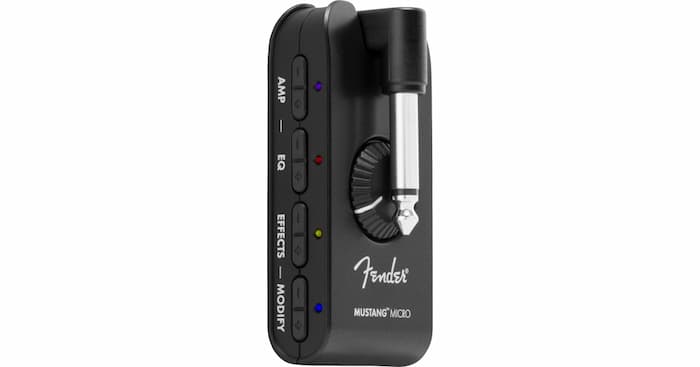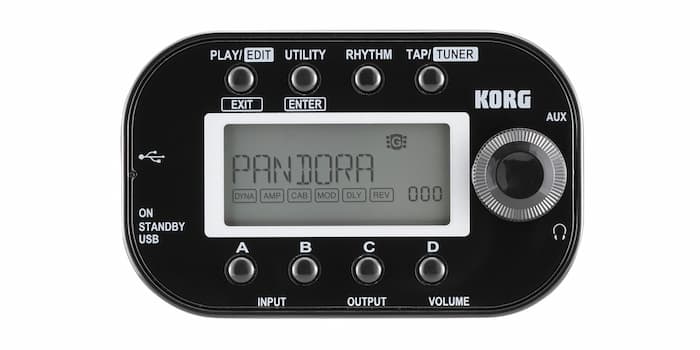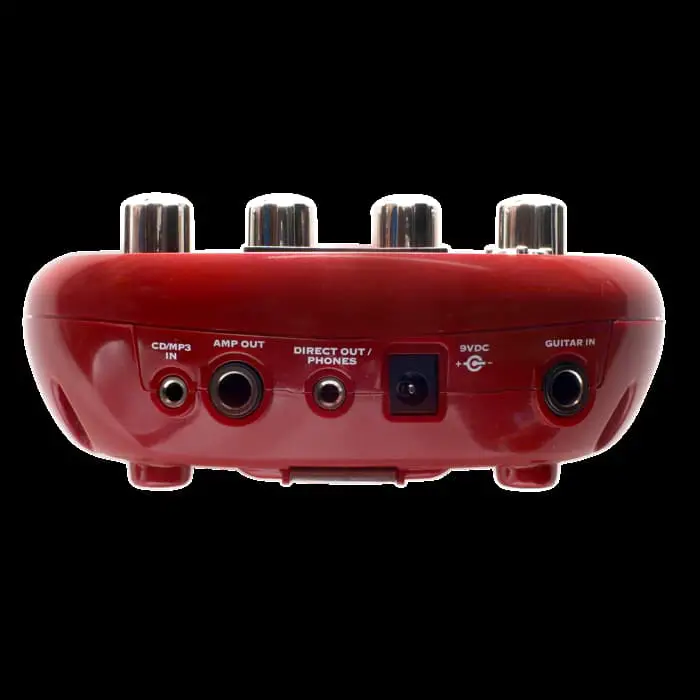For the gigging guitarist, amp modelling pedals can be a lifesaver, as they’re super-portable fly-rigs with enough sounds to get you through a set. Even for those at home practice sessions, they can be a potent tool.
The line 6 pocket pod alone might not be suitable for a pro or semi-pro players; however, they can come in handy for practising or jamming. It’s an easy decision for many guitarists.
There’s nothing new about the concept of having a pocket-sized effect box. Back in the 70s, Dan Armstrong produced a range of (now reissued) tiny effects units that attached directly to the guitar’s jack socket, and the digital technology of the nineties saw Zoom’s strap-mounted 9002, followed by Korg’s Pandora range.
What’s different about the line 6 Pocket Pod, is that it’s not a pioneering stab in the dark: it’s another clever twist on an already well-proven and best-selling recipe. The pod range already covers a wide range of guitarists’ needs and budgets, and the Pocket Pod applies the same tried-and-tested approach to a newer format.
Even though the line 6 pocket pod is one of the best options out there when it comes to portable rigs, it may not be to everyone’s taste, so we’ll go through some of the best alternatives for the line 6 pocket pod.
Boss Pocket GT

From new interfaces, mobile devices and amps that figure out chords for you, to computer-based plug-ins that all overlap with multiple duties and communicate with the outside world in some way, we’ve never had so many options when it comes to sounding like and playing along to AC/DC.
With this in mind, the Pocket GT from Boss is a great practice amp modeller designed for the now. At its core, it’s a compact effects processor/amp modeller offering over 100 models that derive from the Boss GT-1, however, the Pocket GT is also equipped with USB to work as your audio interface for recording your guitar with your computer.
Completing the trifecta of sound, it uses USB and wireless, allowing you to hook the Pocket GT up to your phone.
This is fast becoming the standard for many do-it-all products, so what’s different with the Pocket GT? Well, once you hook it up to your mobile device, you’ll need to download the free Boss Tone Studio app to unlock the jewel crown.
The Boss Tone Studio app acts as a gateway to a world of additional features: additional, touchscreen tone editing, sound management, and preset downloads from the Boss tone library. But perhaps its biggest benefit is its ability to connect to YouTube and other streaming services.
The end result is that you can hear your guitar and song audio from your headphones, as well as watching video and controlling the Pocket GT: all of this with minimal cabling and without latency issues is a great bonus.
Boss has even included some digitised versions of some of the classics, such as the Slow Gear and Feedbacker pedals. But the big sell from the Boss Pocket GT is the connectivity and integration with YouTube.
Once you’re hooked up, the Pocket GT is a breeze. You can edit and store presets easier than you would using the GT’s onboard controls. You can manage and download presets, and most importantly add videos to the Session section by pasting in the video URL.
Zoom MS-50G MultiStomp

The Zoom MS-50G is a pedal packed with 55 different sounds (47 effects and eight amp models), 6 of which can be used at the same time. Add a chromatic tuner into the equation, and you’re looking at a pedal for all seasons.
With the facilities onboard, it comes as no surprise that the Zoom MS-50G won’t run from a standard PP3 battery; rather, it uses a pair of AA batteries, which are supplied with the pedal and should give upwards of seven hours of use. It’ll run from a 9-volt adaptor, although it needs one that can put out 500mA, such as Zoom’s AD-16.
The MS-50G is a solid build, with a silver diecast body, 3 knobs and a footswitch. Although it may look like many other small pedals, the physical similarities stop there. The first difference is its neat 4x3mm LCD display, and the second is that the footswitch is surrounded by a 4-way cursor that lets you navigate around the screen. The 3 knobs are soft knobs that can be pressed to call up particular menus and turned to adjust parameters.
In practice, for example, if you want to use an auto-wah for one song and a phaser for the next, you’ll need them saved as patches (possibly consecutively numbered ones for ease), meaning you can simply bend down and press the centre knob, scroll to the desired patch and press the knob again.
Fender Mustang Micro

A pocket-friendly Fender Mustang Micro amplifier with a wealth of great amp models and onboard effects, the Mustang Micro is a phenomenal tool for practice that will both make and enable you to want to play more – anytime and anywhere you want.
Gear is subjective – as guitarists gravitate to different things, sometimes surprisingly when it’s something we didn’t expect to like. However, there’s a fundamental question we like to ask about new guitar gear: will it make guitarists want to play more?
Fender has answered that question with the Fender Play, which successfully tackles the question of how to keep newer guitarists playing.
The Mustang Micro headphone amp has taken some of the modelling tech of the Mustang series of combos and heads and squeezes it into a compact chassis with a 270-degree rotating input jack. When plugging your headphones in, you’ll have access to 12 amps and 12 different effects combos. The amps each have five EQ settings and the effects each have the same number of parameter presets. This’s all accessed by the side with color-coded + / – buttons, which face up while you play.
It’s an excellent selection with the amps running the gamut from direct to clean, crunch and high-gain, encompassing the iconic Fender models like the ’65 Twin, Deluxe and Bassbreaker, up to high-gain Mustang models, the 5150-esque Metal 2000 and the Bogner-style Uber. You can choose from five EQ settings to suit the players’ tastes and pickups, moving from a middle flat setting (white LED), two darker settings and two brighter settings.
The effects treatment is even more canny with its modulated reverb and 2290 Delay and Reverb panned effects which are especially engrossing.
The Fender Mustang Micro can stream audio from your phone via Bluetooth to jam along with, and plug it into your DAW via USB for recording if you wish.
Korg Pandora Mini

Korg’s have produced units for around 1995 and has not only gotten more sophisticated but also smaller with each new model. The latest addition is their ultra-compact Pandora Mini, which comes in black or white and, at just over three inches long, able to slip into any pocket.
The basic premise of the Pandora has always been to provide a portable practice tool that provides a variety of fully produced guitar and bass sounds.
The Mini uses Korg’s REMS modelling technology to provide 158 different effects over seven categories (dynamics, pickup modelling, amp modelling, cab modelling, modulation, delay, reverb and noise reduction) that are chained together making a selection of 200 preset programs (160 for guitar, 40 for bass). The unit also has 200 user locations for storing your own sounds.
If you want something to play along with, not only is there an onboard metronome but also 100 different rhythm patterns with adjustable control over tempo, volume and reverb.
You can also jam along to your favourite songs on CD and mp3 by plugging a player into the Mini’s aux input – it has a variable pitch function lets you match the key of the song to the tuning of your guitar.
Sounds
The first port of call for anyone trying the Korg’s Pandora Mini for the first time has to be diving in and auditioning the presets, where you’ll find sounds suitable for a wide range of musical genres and playing styles, demonstrated ably by 115 song presets designed to recreate the specific sound used by a famous guitarist along with one of their signature tunes.
Among these, you’ll find many familiar names – including widely regarded classic guitar tracks and others that are more leftfield. There’s defiantly something for everyone.
Editing is easy to do using the front panel buttons and rotary dial, but the dedicated sound editor software (available as a free download from the Korg website) on a connected computer makes editing and managing programs even easier.
You can play away to your heart’s content in isolation, however, the really great thing about the Korg’s Pandora Mini is that you can play along with drum rhythms – which is brilliant for improving your timing in a range of styles, time signatures and tempos (via the tap tempo button or rotary dial) and also inspirational in getting you to play stuff you might never have thought of while giving you a solid foundation for songwriting as well.
